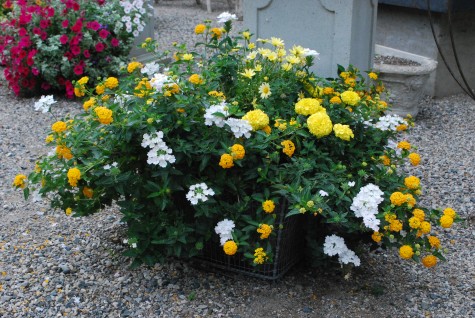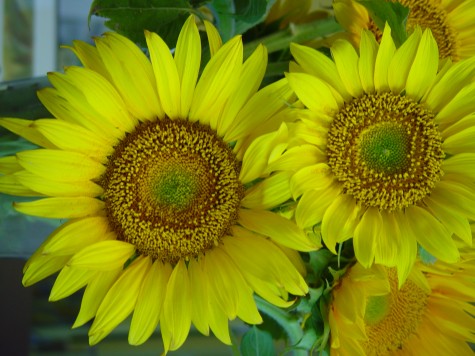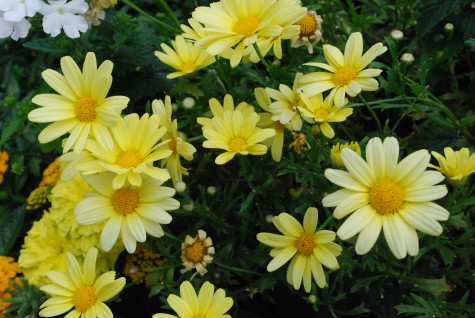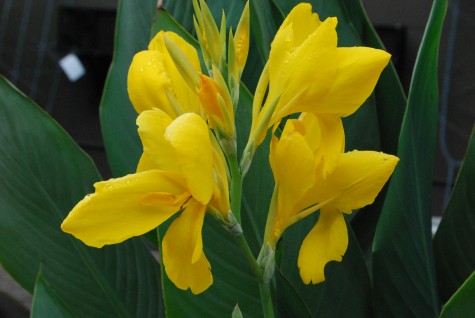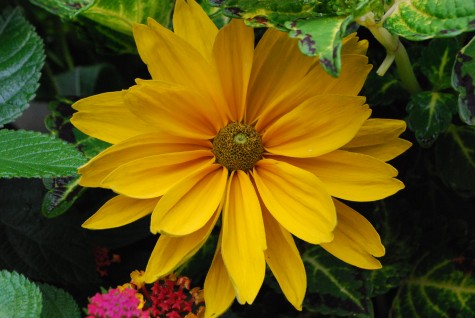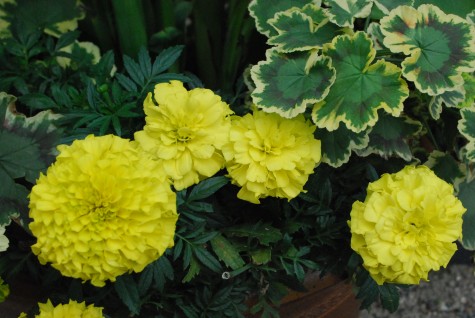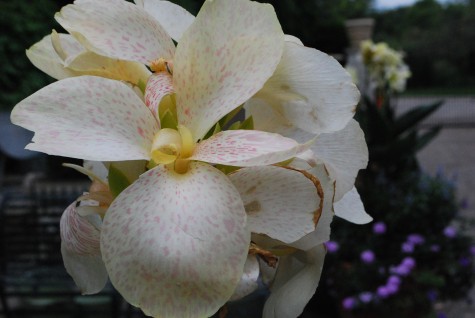Archives for September 2011
At A Glance: Late Summer Yellow
The Making Of The Pots
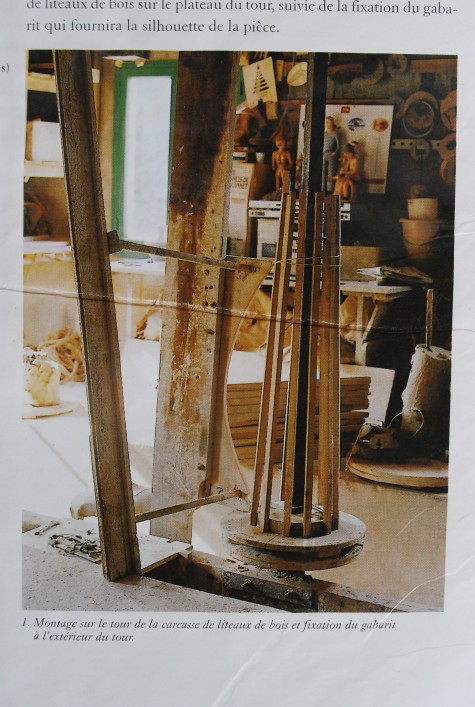 What I know about making terra cotta pots wouldn’t fill a teacup, but I have pictures. These first four are from a book Rob bought for me in France 15 years ago. “Terres Vernissees” by Christine Lahaussois and Beatrice Pannequin is an overview of the art of French glazed ceramics dating back to the 16th century. This method of making large pots with wood armatures wrapped in rope is a centuries old technique. The form begins with a series of wood verticals that describe the height of the piece, and the diameter of the top and the bottom.
What I know about making terra cotta pots wouldn’t fill a teacup, but I have pictures. These first four are from a book Rob bought for me in France 15 years ago. “Terres Vernissees” by Christine Lahaussois and Beatrice Pannequin is an overview of the art of French glazed ceramics dating back to the 16th century. This method of making large pots with wood armatures wrapped in rope is a centuries old technique. The form begins with a series of wood verticals that describe the height of the piece, and the diameter of the top and the bottom.
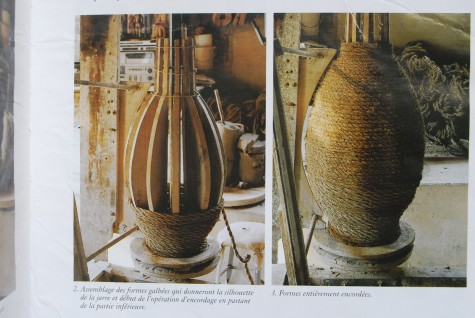 Multiple wood ribs that describe the overall shape of the pot are fixed to the central verticals. Keep in mind that the pots are made top side down. Heavy rope is carefully wrapped around the wood ribs. The ribs and the rope create a template for the finished shape of the pot. Wet clay is very heavy, and very sticky. To throw a pot of great size takes multiple passes. Only so much of the finished height of the pot can be done before the pot needs to rest, and the clay become leather hard. Then the next layer can be added. A giant pot thrown on a wheel all at once would collapse under its own weight. It is much more efficient to press the sticky clay into the rope. The form keep the clay from succumbing to gravity.
Multiple wood ribs that describe the overall shape of the pot are fixed to the central verticals. Keep in mind that the pots are made top side down. Heavy rope is carefully wrapped around the wood ribs. The ribs and the rope create a template for the finished shape of the pot. Wet clay is very heavy, and very sticky. To throw a pot of great size takes multiple passes. Only so much of the finished height of the pot can be done before the pot needs to rest, and the clay become leather hard. Then the next layer can be added. A giant pot thrown on a wheel all at once would collapse under its own weight. It is much more efficient to press the sticky clay into the rope. The form keep the clay from succumbing to gravity.
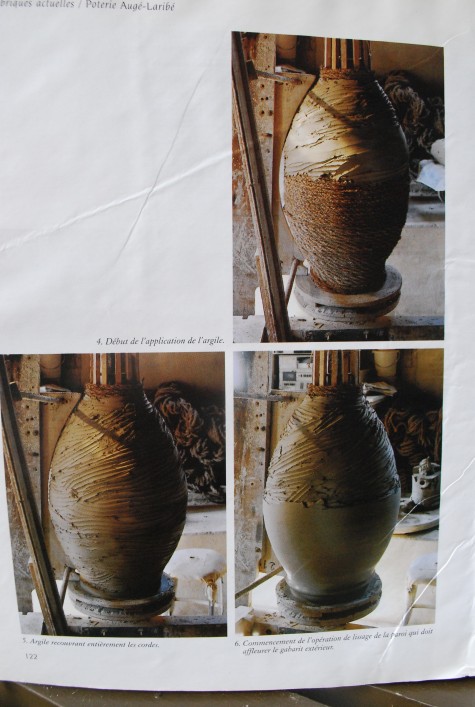 These pictures detail how the wet clay is pressed into the rope covered form. The texture you see here-the finger marks of the person making this pot. The evidence of the human hand-this is what these pots are all about. These large pots have been made this way for centuries in France. I think it is of utmost importance that this history be known, and appreciated. I appreciate modern technology, and the important news of the moment, but there is more out there. When I plant a beautiful handmade pot, the planting is as much about the the history of the making, and the maker of the pot, as it is about the plants.
These pictures detail how the wet clay is pressed into the rope covered form. The texture you see here-the finger marks of the person making this pot. The evidence of the human hand-this is what these pots are all about. These large pots have been made this way for centuries in France. I think it is of utmost importance that this history be known, and appreciated. I appreciate modern technology, and the important news of the moment, but there is more out there. When I plant a beautiful handmade pot, the planting is as much about the the history of the making, and the maker of the pot, as it is about the plants.
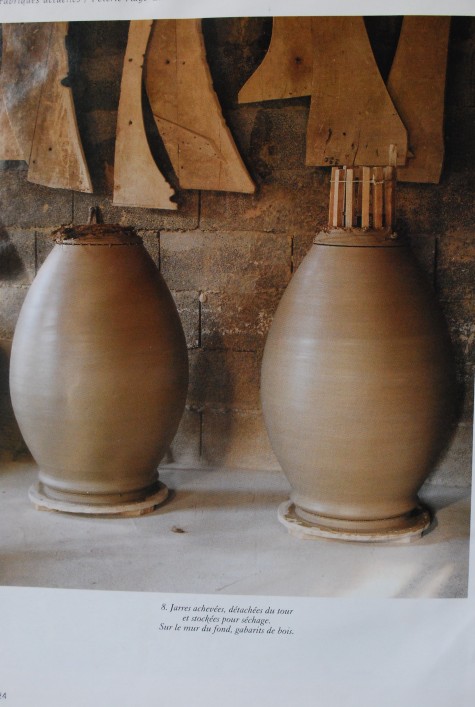 Once the wet clay is pressed into the ropes, the wheel turns, and the surface is smoothed. The wood form is collapsed once the clay becomes leather hard. The clay is cut, and the form removed. The rope? The rope is removed before the pot is fired, saved, and used again.
Once the wet clay is pressed into the ropes, the wheel turns, and the surface is smoothed. The wood form is collapsed once the clay becomes leather hard. The clay is cut, and the form removed. The rope? The rope is removed before the pot is fired, saved, and used again.
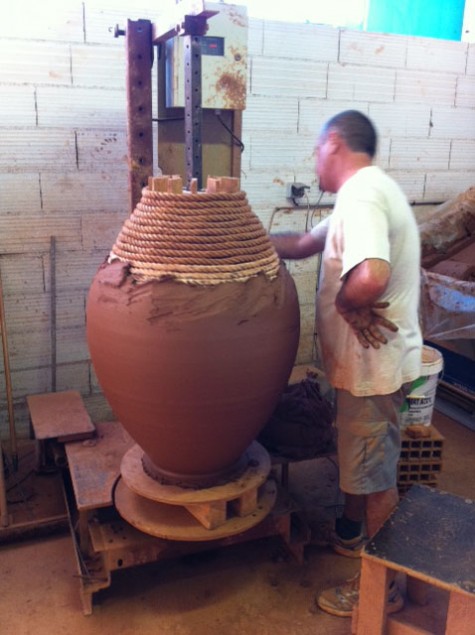
Rob took this picture 2 days ago. That the construction of the giant vases has not changed for several centuries-this is very important to me. How so? The handmade French pots that will come to the shop in 2 months will have been made by a person, whose hand, skill and judgment will enchant me. The history is long, the commitmment-just as long. People who make extraordinary things-I value them. I do what I can to support this industry, and am always sorry when I see a poterie close. The making of the pots is an art I would like to see endure.
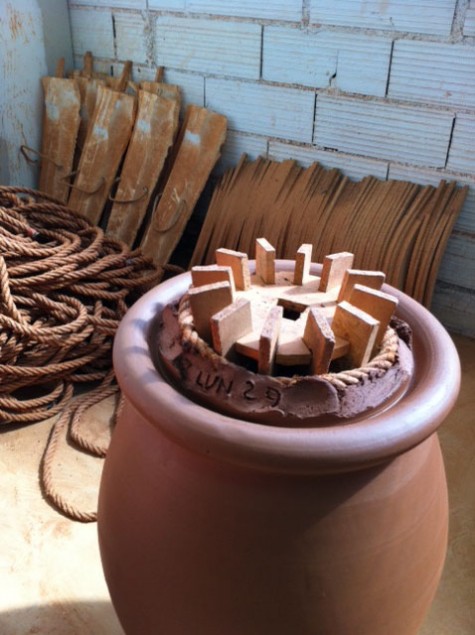 The finished pots in my shop do not tell this story. Yes, they have beautiful shapes and graceful curves. They are heavy, solid-very well made. With proper care, they will last better than a lifetime. But the story of how they are made makes for a story any passionate gardener would want to hear.
The finished pots in my shop do not tell this story. Yes, they have beautiful shapes and graceful curves. They are heavy, solid-very well made. With proper care, they will last better than a lifetime. But the story of how they are made makes for a story any passionate gardener would want to hear.
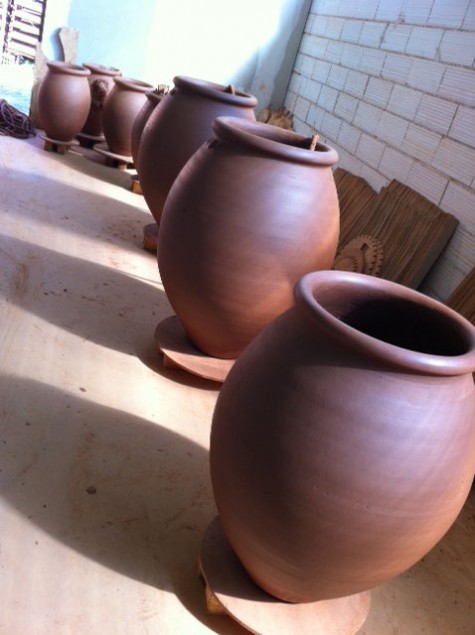 The finished pots-they need to rest.
The finished pots-they need to rest.
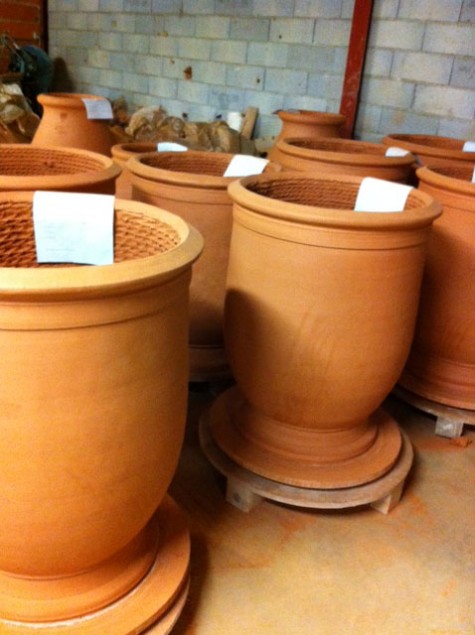 Once they dry, the pots will be fired. The rope is removed, but the pattern of that rope will be fired and live forever in the interior of the pot. The interior of the pot is every bit as beautiful as the exterior surface. These pots are ready to be planted.
Once they dry, the pots will be fired. The rope is removed, but the pattern of that rope will be fired and live forever in the interior of the pot. The interior of the pot is every bit as beautiful as the exterior surface. These pots are ready to be planted.
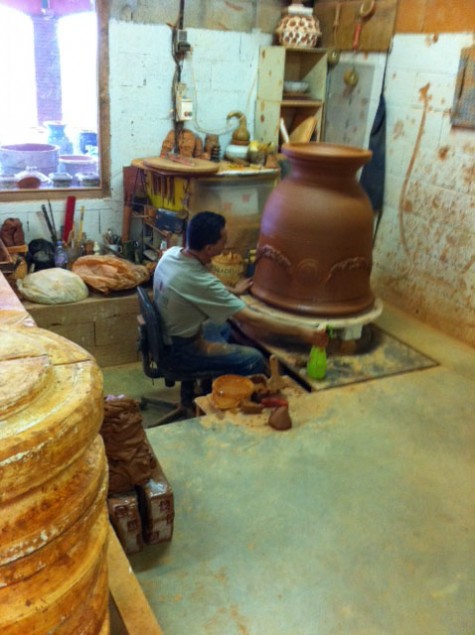 Some of the pots get decoration. Once the clay is leather hard, a potter will work hard to create and affix that garland, that medallion to the body of the pot.
Some of the pots get decoration. Once the clay is leather hard, a potter will work hard to create and affix that garland, that medallion to the body of the pot.
 Giant pots drying have supports. These supports are not so fancy, just useful. Simply useful. Gravity can drag down wet clay. These not so fancy supports keeps the wet clay aloft.
Giant pots drying have supports. These supports are not so fancy, just useful. Simply useful. Gravity can drag down wet clay. These not so fancy supports keeps the wet clay aloft.
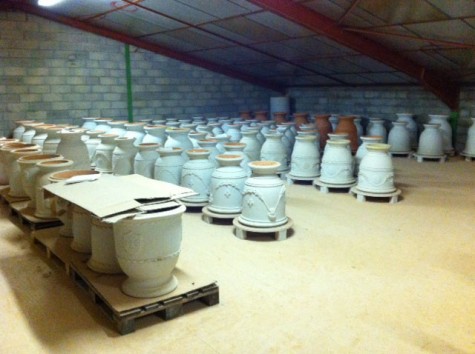 The attic is a perfect drying room. Imagine that every handmade French pot gets hauled to the attic to dry. There are a lot of steps, and a lot of hands that come together to make these pots. When they are thoroughly dry, they will be fired. From these hands to yours-Rob does this part.
The attic is a perfect drying room. Imagine that every handmade French pot gets hauled to the attic to dry. There are a lot of steps, and a lot of hands that come together to make these pots. When they are thoroughly dry, they will be fired. From these hands to yours-Rob does this part.
Especially For You, Mathias
 I have clients in Ann Arbor, Michigan. Michael, and Mathias. I am due to make a landscape design presentation regarding their property September 10. It has taken 18 months to get to know one another, and set a firm date. Michael has a Renaissance sensibility. He can hold his own about farming, romance, music, culture, gardens, a passionately lived life is his life; I am also quite sure he could fix a broken zipper with dispatch. Matthias is French. He is reserved, except where his dog Banjo, his garden, and his love for France is concerned. He is talented, kindly, compassionate, and passionately French. When Rob sent me this first picture from France, I thought first of Mathias. Though his experience is more urban than this picture would suggest, I am thinking a lot about a culture other than my own. Rob drove down this two-track dirt road after shopping all day, to have dinner with friends- French friends.
I have clients in Ann Arbor, Michigan. Michael, and Mathias. I am due to make a landscape design presentation regarding their property September 10. It has taken 18 months to get to know one another, and set a firm date. Michael has a Renaissance sensibility. He can hold his own about farming, romance, music, culture, gardens, a passionately lived life is his life; I am also quite sure he could fix a broken zipper with dispatch. Matthias is French. He is reserved, except where his dog Banjo, his garden, and his love for France is concerned. He is talented, kindly, compassionate, and passionately French. When Rob sent me this first picture from France, I thought first of Mathias. Though his experience is more urban than this picture would suggest, I am thinking a lot about a culture other than my own. Rob drove down this two-track dirt road after shopping all day, to have dinner with friends- French friends.
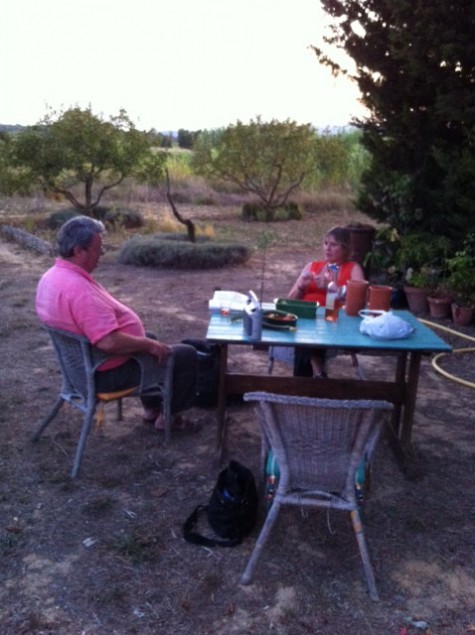 They have a house in town. They have a garden property some distance away. The garden has a small structure that houses a kitchen, a sink, and a bathroom. She calls that building the hut. They grow vegetables and herbs here. The water canal brings water to their garden. It is quiet, dusty, unpretentious-the perfect place to decompress, have a glass of wine, and fashion a dinner. They come here quite often. Rob told me about their place and this evening in great detail-no wonder. It is a landscape, and a way of life that could not be further from his own.
They have a house in town. They have a garden property some distance away. The garden has a small structure that houses a kitchen, a sink, and a bathroom. She calls that building the hut. They grow vegetables and herbs here. The water canal brings water to their garden. It is quiet, dusty, unpretentious-the perfect place to decompress, have a glass of wine, and fashion a dinner. They come here quite often. Rob told me about their place and this evening in great detail-no wonder. It is a landscape, and a way of life that could not be further from his own.
 The landscape of this house is mostly about the existing native landscape. The plant choices are dictated by the climate; a few treasured plants are grown in pots-herbs, vegetables, citrus trees. There is a lot of bare dirt, and even more gravel-it is a dry climate, and gardens acknowledge this. They are cultivated in a different way. I cannot really explain what I mean by this, except to say that the gardens are more about coexistence, and less about intervention.
The landscape of this house is mostly about the existing native landscape. The plant choices are dictated by the climate; a few treasured plants are grown in pots-herbs, vegetables, citrus trees. There is a lot of bare dirt, and even more gravel-it is a dry climate, and gardens acknowledge this. They are cultivated in a different way. I cannot really explain what I mean by this, except to say that the gardens are more about coexistence, and less about intervention.
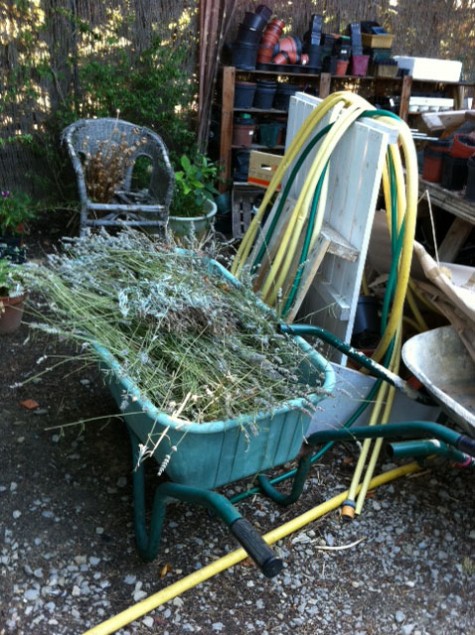 No where in my garden do I have a wheelbarrow full of lavender; this picture makes me long for for it. This garden is not for show, it is for living. As much as it is a living space, it is unabashedly a working space. There is something so comfortable and inviting about this space; there is an authenticity of place. Do I have anything like this-no. But what becomes so valuable about this landscape is what there is to be learned about another place, another climate, another environment.
No where in my garden do I have a wheelbarrow full of lavender; this picture makes me long for for it. This garden is not for show, it is for living. As much as it is a living space, it is unabashedly a working space. There is something so comfortable and inviting about this space; there is an authenticity of place. Do I have anything like this-no. But what becomes so valuable about this landscape is what there is to be learned about another place, another climate, another environment.
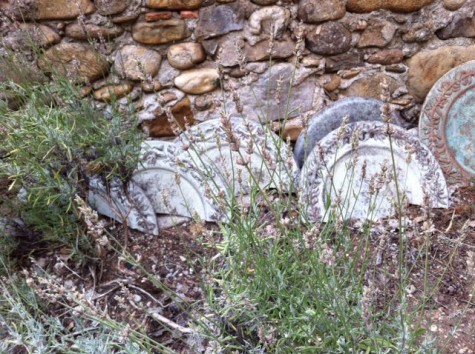 This poterie garden is ornamented with terra cotta trays, broken in the kiln. It seems appropriate, this. Though broken terra cotta plates may not translate directly to my experience, there is that idea that the most ordinary of things become ornamental given how they are placed. The beauty of a garden is very much about its identity.
This poterie garden is ornamented with terra cotta trays, broken in the kiln. It seems appropriate, this. Though broken terra cotta plates may not translate directly to my experience, there is that idea that the most ordinary of things become ornamental given how they are placed. The beauty of a garden is very much about its identity.
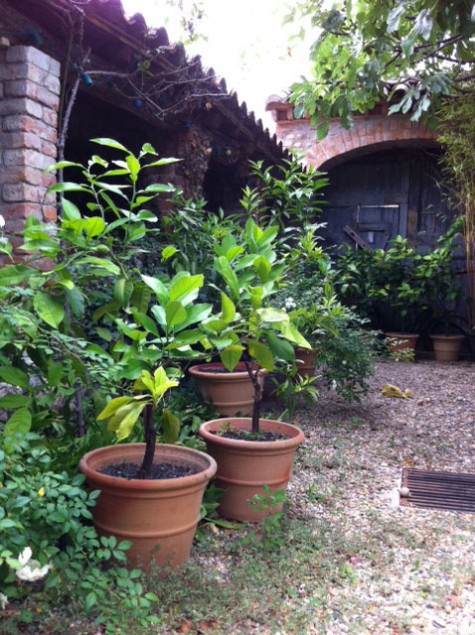 This collection of citrus trees in pots, and the orangerie boxes with their citrus trees at Versailles differ only in degree. French gardeners value their lemons, oranges and limes enough to cultivate them in pots. I have seen so many textiles, pottery and dinnerware from the south of France in the colors of fruits. That French blue? The color of the sky, or the Mediterranean.
This collection of citrus trees in pots, and the orangerie boxes with their citrus trees at Versailles differ only in degree. French gardeners value their lemons, oranges and limes enough to cultivate them in pots. I have seen so many textiles, pottery and dinnerware from the south of France in the colors of fruits. That French blue? The color of the sky, or the Mediterranean. 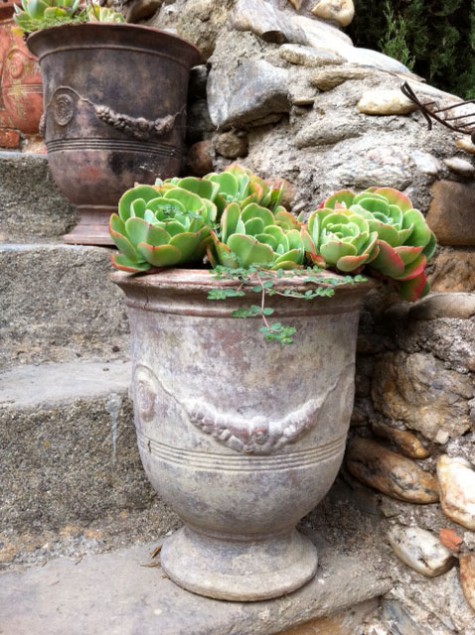 This terra cotta pot with its succulents and trailing weed-nothing fussy here about the planting, or the care required. The finish on the terra cotta so beautifully reflects the natural stone and mortar in the stairs and wall. This container planting is subtle, and satisfying.
This terra cotta pot with its succulents and trailing weed-nothing fussy here about the planting, or the care required. The finish on the terra cotta so beautifully reflects the natural stone and mortar in the stairs and wall. This container planting is subtle, and satisfying.
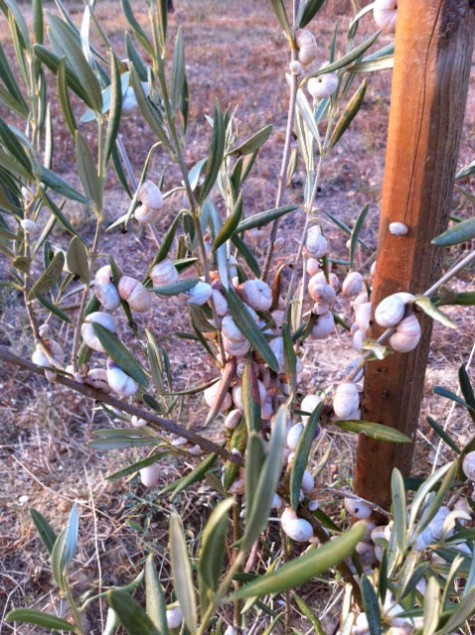 This olive tree is unexpectedly studded with snails, not olives. This is indeed a landscape completely unlike my own.
This olive tree is unexpectedly studded with snails, not olives. This is indeed a landscape completely unlike my own.
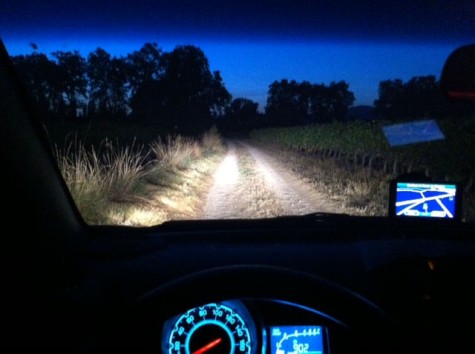 The landscape that runs right up to the sides of this two track-equally unlike my paved roads with their curbs, medians and street signs. This kind of peace and quiet is compelling. Mathias-his property has elements exactly like this. Part of my job as a designer is to recognize the natural beauty of that place. The landscape will have to recognize, not dilute or compromise what needs little help from me in the first place. No doubt a kitchen garden, and fruit trees will figure prominently in the design.
The landscape that runs right up to the sides of this two track-equally unlike my paved roads with their curbs, medians and street signs. This kind of peace and quiet is compelling. Mathias-his property has elements exactly like this. Part of my job as a designer is to recognize the natural beauty of that place. The landscape will have to recognize, not dilute or compromise what needs little help from me in the first place. No doubt a kitchen garden, and fruit trees will figure prominently in the design. 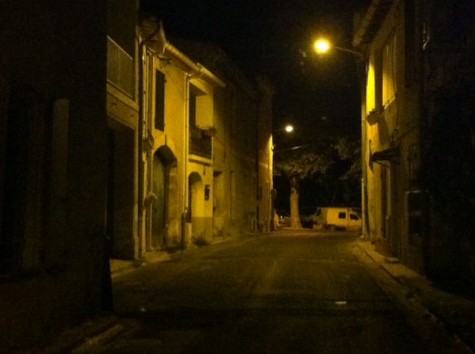
For 9 nights, this street in France, with the buildings run right up to the road will be Rob’s home away from home. Every time he shops overseas, he adds to his knowledge of gardening and ornamenting the gardens practiced in other places. How he sees that fitting with how we garden here fuels and enriches his choices. No doubt this gets passed along to me. In turn, I hope it will influence how I design.
